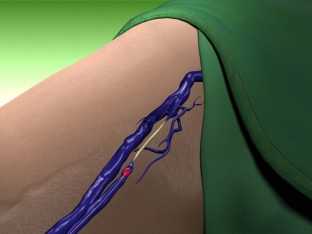Acute or chronic inflammation of the walls of the venous network is called phlebitis. In most cases, phlebitis appears as a complication of varicose veins of the lower extremities. Usually, the inflammatory process in the venous network proceeds with the formation of blood clots, and the process turns into thrombophlebitis. It is not easy to detect the presence of phlebitis at an early stage, but it is very important, since early diagnosis and treatment prevents venous thrombophlebitis, which is often complicated by pulmonary embolism. Read the types and clinical manifestations of phlebitis at estet-portal.com.
What are phlebitis depending on the cause and localization of the process?
Depending on the location of the inflammatory process in the venous network, phlebitis occurs:
- Endophlebitis – damage to the inner lining of the veins. Appears against the background of damage to the inner lining of the vessel. Endophlebitis can be caused by catheterization of a vein or a long stay of a needle in it with a drip of the drug. Endophlebitis is one of several side effects of hypertonic saline injected into a vein.
- Periphlebitis – damage by the inflammatory process of the outer shell of the veins. It develops during the transition of the inflammatory process from the surrounding tissues to the walls of the veins.
- Panphlebitis – damage to all membranes of the veins.
Depending on the cause, phlebitis can be:
- Migrating – appears in young men. Superficial veins of the upper and lower extremities are affected, arteries are affected. Such phlebitis is prone to recurrent long course.
- Painful phlebitis – develops in women after childbirth and affects the veins of the lower extremities. It has a pronounced pain syndrome and an acute course.
- Allergic phlebitis – has a chronic benign course, appears as a result of an allergic reaction.
- Cerebral phlebitis develops against the background of infections associated with lesions of the cerebral vessels.
- Pylephlebitis – develops as a complication of inflammatory processes in the abdominal cavity.
Phlebitis against the background of an infectious process can develop in any part of the vein of the entire human body.

What causes lead to phlebitis? Why is phlebitis caused artificially?
The most common cause of phlebitis is varicose veins. Also, phlebitis of the veins can develop after an abscess, an infectious disease, or due to an infected wound. Most often, with the development of inflammation of the venous network, the causative agent is streptococcus. Phlebitis can also begin after a chemical burn of a vein.
Modern medicine, namely phlebology, uses the process of phlebitis in some cases, causing it artificially. So, in the treatment of varicose veins, sclerotherapy is used, which consists in the introduction of a special chemical substance intravenously. This substance causes aseptic phlebitis, due to which the walls of the veins stick together.
How to recognize phlebitis? Clinical manifestations of all types of phlebitis
In an acute superficial process, the skin over the damaged vein becomes tense and painful, turns red, becomes dense and hot to the touch. Sometimes red streaks appear along the inflamed vein.
In acute phlebitis of the deep veins of the limb there is general weakness, fever, swelling and pain in the area of inflammation. The color of the skin of the limb becomes white. Reddening of the skin over the site of inflammation of the veins with deep vein phlebitis is not observed. Acute phlebitis of deep veins in most cases is complicated by the formation of blood clots in the wall and turns into deep vein thrombophlebitis.
Chronic phlebitis is manifested by a recurrent course with periodic exacerbations. There is also cerebral phlebitis, which is manifested by an increase in blood pressure, headache and neurological symptoms. Phlebitis of the penis is manifested by sharp pains, bluish color of the penis and swelling.
Pylephlebitis (phlebitis of the collar vein) is manifested by severe intoxication, vomiting, weakness, headache. There are intense pains of a cramping cutting nature, which are localized in the right hypochondrium. The condition is complicated by the presence of hectic fever with profuse sweats and chills. Pylephlebitis can become chronic with the development of liver and kidney failure.
What are the basics of effective treatment of venous phlebitis?
Diagnosis is carried out using duplex scanning, ultrasound of the veins. Phlebitis requires conservative therapy with an integrated approach. Hospitalization is indicated for all types of phlebitis, except for phlebitis of the superficial veins. Limbs with phlebitis need rest and an elevated position. Treatment is aimed at eliminating inflammation, improving the condition of the blood and nutrition of the vein wall. In some cases, patients are prescribed compression stockings.
If there are symptoms of phlebitis, it is important to undergo a diagnosis in a timely manner, after which a treatment regimen is prescribed. This is important to prevent thrombophlebitis, which requires surgery.







Add a comment